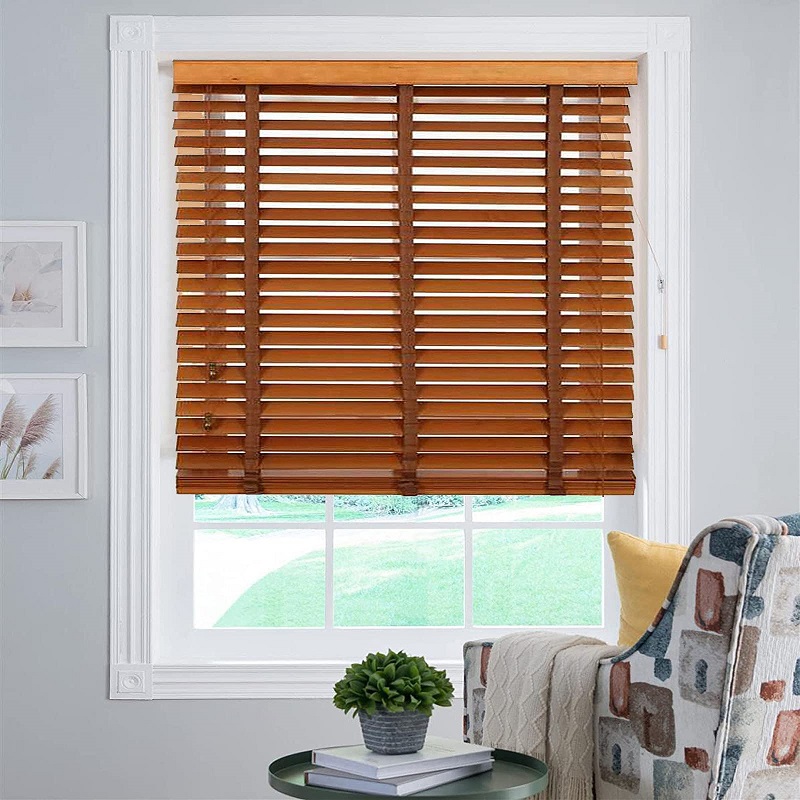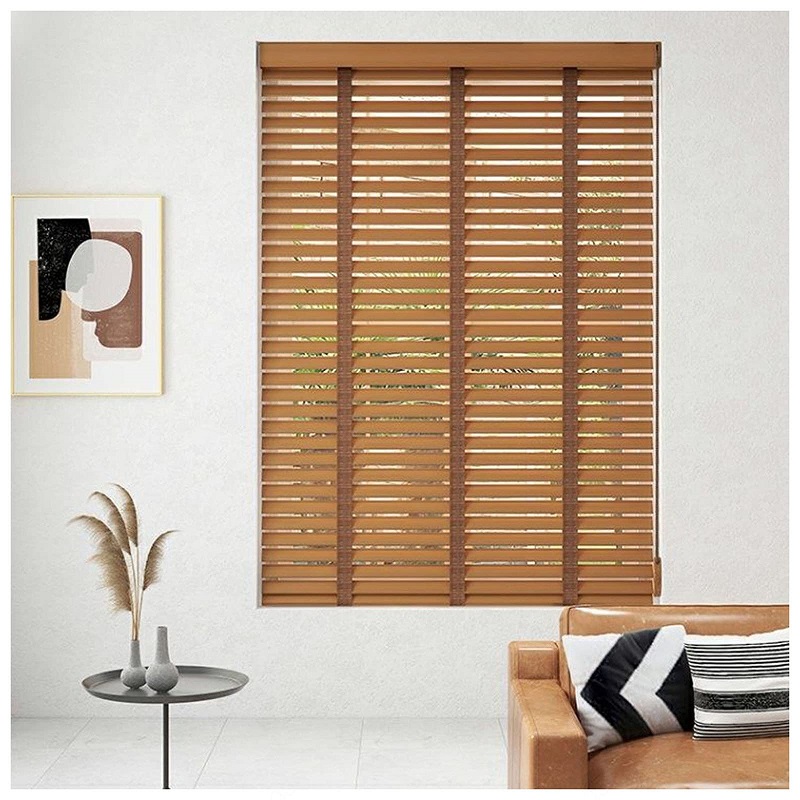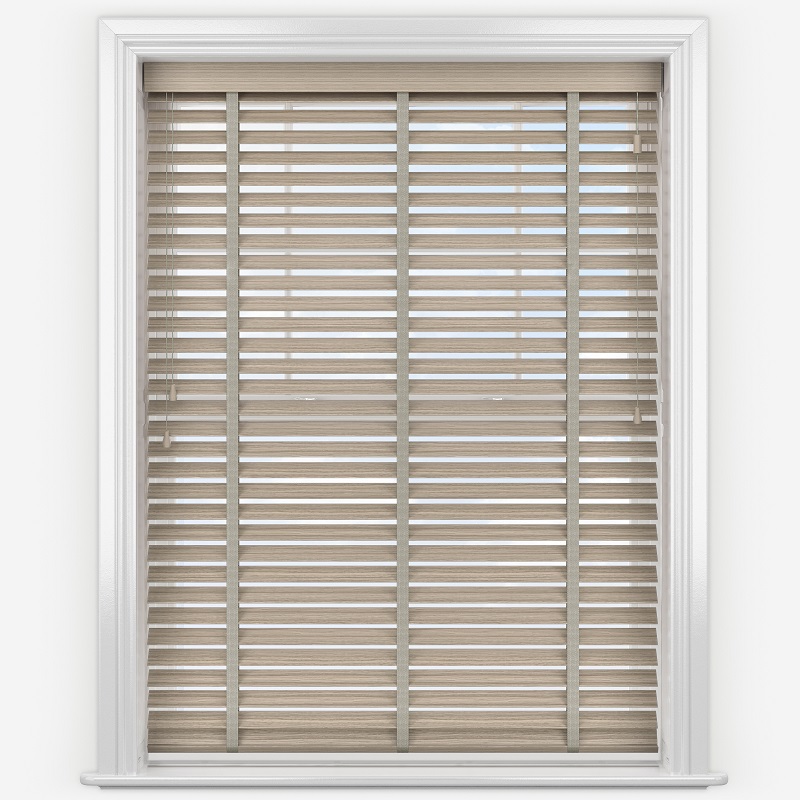Identifying Your Wooden Blinds
Before starting your cleaning journey, it’s essential to identify whether you have real wood or faux wood blinds. Real wood blinds display unique, irregular grain patterns, indicating the use of natural wood. These blinds require gentle care as water and harsh cleaning agents can damage their finish.
On the other hand, faux wood blinds often have uniform grain patterns, thanks to their synthetic materials like PVC or composite polymers. Faux wood is more durable and less prone to warping. They can handle most mild cleaners but steer clear of strong detergents that could harm the blinds.
To confirm the type of your wooden blinds, observe the grain patterns or check with the manufacturer if possible. Knowing this will guide your cleaning methods, ensuring you use the safest and most effective approach. For real wood blinds, dry methods such as dusting are preferable, while faux wood can tolerate slightly damper cleaning techniques.
Introduce regular dusting and the use of appropriate cleaners into your household routine, and you’ll maintain the blinds’ beauty and functionality. Equip yourself with this knowledge, and you’re ready to progress to the cleaning steps outlined in the next sections.

Routine Dusting for Wooden Blinds
Dusting your wooden blinds regularly is vital for maintaining their appearance and functionality. Here’s a straightforward approach to routine dusting:
- Use the Right Tool: Grab a feather duster or a microfiber cloth, which are gentle on blinds and effective at grabbing dust.
- Close the Blinds: Adjust the slats so they lie flat and close together. This position exposes the maximum surface area for dusting.
- Dust Each Slat: Starting from the top, dust each slat from end to end. Support the slat with your hand to avoid bending.
- Flip and Repeat: Once you’ve dusted one side, rotate the blinds to dust the other side, ensuring total coverage.
- Regular Schedule: Incorporate dusting into your weekly cleaning ritual to prevent dust buildup.
By dusting weekly, you can prevent allergens and dirt from accumulating, which is particularly beneficial for those with allergies.
To avoid the dangers of improper cleaning, never use water or liquid cleaners on real wood blinds, and don’t press too hard to prevent scratching their delicate surfaces. Remember, effective dusting extends the life and beauty of your wooden blinds, and keeps your home looking and feeling fresh.
Deep Cleaning Wooden Blinds
When your regular dusting just isn’t enough, it’s time for a deep clean of your wooden blinds. Start by gathering gentle cleaning supplies like a soft brush or a lint-free microfiber cloth that won’t scratch or damage your blinds’ finish. You’ll also need mild detergent or a DIY mix of water and vinegar for a natural, non-abrasive solution.
Pre-Cleaning Steps
Before you begin, carefully remove any loose dust with a vacuum, using the brush attachment to avoid scratching the slats. This step ensures that you’re starting with a clean slate and reduces the risk of pushing dirt around.
Cleaning Wood Slats
Moisten your cloth with the cleaning solution, and wring it out so it’s damp, not wet, to avoid water damage to the wood. Support the slat from below with one hand, and clean from one end to the other with your other hand. After wiping, immediately dry the slat with another lint-free cloth to prevent any moisture from soaking in and warping the wood.
Addressing Tough Spots
For any stubborn dirt or residues, use your soft brush or swap it for a toothbrush for more precise scrubbing. Apply gentle pressure to avoid damage, and always follow up with a dry cloth.
Drying the Blinds
Ensure all slats are dry by wiping them down with a clean, dry cloth. Leaving any moisture behind can cause damage over time. If possible, leave the blinds lowered in a well-ventilated area to air dry.
By following these steps, you can safely and effectively deep clean your wooden blinds, preserving their look and extending their lifespan. Remember, regular maintenance can prevent the need for frequent deep cleans and keep your blinds looking their best.

Cleaning Faux Wooden Blinds
When it comes to faux wooden blinds, cleaning is less complex. Here’s how to keep them shining:
- Use Mild Solutions: Mix water with a drop of mild detergent. Avoid harsh chemicals.
- Soft Cloth Application: Dip a soft cloth in the solution, wring it well, then wipe the slats.
- Gentle Dusting: A microfiber cloth or a duster can effectively remove loose dust.
- Vacuum: Use the brush attachment on your vacuum for a quick dust-off.
- Dry Thoroughly: After cleaning, ensure each slat is dry to avoid moisture damage.
Faux wood can withstand moist cleaning better than real wood. Yet, careful drying is crucial to prevent any potential warping. Clean spills quickly to maintain the pristine look of your faux wooden blinds.
Remember, regular cleaning maintains the blinds’ look and prevents the build-up of grime. By following these straightforward steps, your faux wooden blinds will remain clean and look new for longer periods.
Dangers of Improper Cleaning
Improper cleaning of wooden blinds can cause many issues. Moisture is a big risk for real wood blinds. Too much water can make them warp or crack. Harsh chemicals can harm both real and faux wood blinds. They can strip the finish. They can also create stains that are tough to remove. Rough cleaning tools or scrubbing hard can scratch or damage the wood. Always use gentle tools and mild cleaners to avoid these problems.
Be careful not to leave water on the blinds. Water can cause discoloration and spots. Dry the blinds right away with a clean cloth. Even faux wood blinds can warp if left wet for too long.
Avoid strong soaps and detergents. They can wear down protective coatings on the blinds. This can make them look dull and old.
Don’t use rough cloths or sponges. They can leave scratches. Always use soft cloths or microfiber towels.
Proper cleaning will keep your wooden blinds looking good. It will also help them last longer. Always follow the right cleaning methods for the type of blinds you have. This will avoid damage and extra costs for repairs.
Maintaining Wooden Blinds
Maintaining wooden blinds involves regular care beyond usual cleaning routines. To ensure longevity and preserve their aesthetic, consider the following tips:
- Avoid Harsh Chemicals: Use only mild cleaners to prevent damaging the blinds’ finish.
- Moisture Management: Excess water can harm wood blinds. Use a slightly damp cloth for cleaning and dry immediately.
- Frequent Dusting: Dust wooden blinds every few weeks. This keeps them looking fresh and reduces wear and tear.
- Gentle Touch: When handling blinds, use care. Avoid using hard brushes or rough cloths that can scratch the surface.
- Regular Inspections: Check for signs of damage such as warping or discoloration. Address issues quickly to prevent further harm.
For real wood, a periodic application of wood conditioner or oil can enhance the protective layer, adding sheen to the slats. On faux wood, wiping them down with a vinegar and water solution can fend off grime and keep them looking new.
By adhering to these maintenance steps, you can extend the life of your wooden blinds, ensuring they remain a beautiful part of your home’s decor for a considerable time. Remember, proper maintenance today saves on costly repairs or replacements in the future.

Cleaning Difficult-to-Reach Areas
When cleaning wooden blinds, some areas can be tricky to get to. Here’s how to handle them:
- Top of the Slats: Dust accumulates here. Use a flat, soft dusting tool.
- Corners and Edges: These collect dirt. Angle your cleaning tool to reach into these spots.
- Between Slats: Narrow spaces can trap dust. Use a slim duster or a soft-brush vacuum attachment.
- Brackets and Hardware: Use a dry or slightly damp microfiber cloth to wipe.
- Behind the Blinds: Gently pull blinds away from the window. Dust with a long-handled duster.
Mind the material of your blinds when cleaning hard-to-reach areas. For real wood, keep moisture to a minimum and avoid harsh chemicals. Faux wood may be more forgiving, but still, treat them with care. Regular attention to these areas helps maintain the blinds’ function and look.
FAQs and Professional Advice
What’s the best method to clean wooden blinds?
To clean wooden blinds, dust them regularly with a feather duster or microfiber cloth. For deeper cleaning, use a damp rag with mild detergent, and instantly dry the slats with a clean cloth to prevent damage.
Can I use water to clean real wood blinds?
Real wood blinds should not get wet. Clean them with as little moisture as possible, using a slightly damp cloth. Quickly dry each slat after cleaning.
Are there alternative methods for cleaning faux wood blinds?
You can dust faux wood blinds with a cloth or use a vacuum with a soft brush attachment. For tougher grime, gently wipe the slats with a mild soap and water solution, then dry thoroughly.
How often should I dust my wooden blinds?
Dust wooden blinds at least once every few weeks to keep them clean and reduce wear and tear. In dusty environments or if you have pets, dust them more frequently.
Is it safe to use vinegar on wooden blinds?
While a mix of vinegar and water is great for faux wood blinds, avoid using it on real wood to prevent potential harm to the finish.
How can I maintain the finish on my wooden blinds?
For real wood, occasionally apply a wood conditioner or oil to enhance protection and shine. Faux wood blinds may be wiped down with a vinegar solution for added cleanliness.
How do I clean hard-to-reach areas?
Use slim dusters or a vacuum with a soft brush to reach between slats and around hardware. Always support the slats to prevent bending while cleaning.
Employ these tips and techniques to keep your wooden blinds in top condition, ensuring they function well and add to your home’s charm. Regular maintenance and correct cleaning methods will help your wooden blinds last longer and look better.








